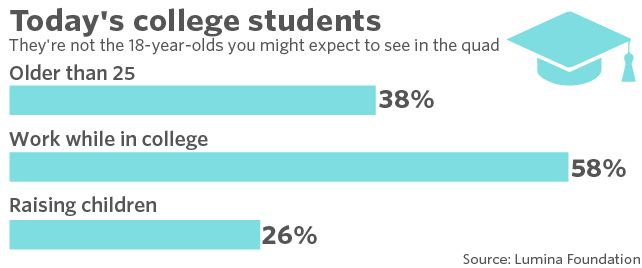While many tend to think of the “typical” college student as an 18-22 year-old who lives on campus and attends classes full time, in reality, nearly 40% of undergraduate students are older than 25, about 58% are working while attending college, and more than one-quarter are parents, according to data from the Lumina Foundation, a nonprofit dedicated to increasing the share of Americans with post-high school credentials. As a recent MarketWatch story notes, many of today’s college students fit all three of these categories.
Despite this change in the makeup of college campuses, many colleges are still geared towards traditional residential students, aged 18-22, which makes it difficult for students of different ages or differing circumstances to navigate campus and academic life.
These college campus trends are also reflected in Utah’s higher education student body population, and Utah institutions are working to help these non-traditional students succeed in college.
For example, SLCC, recently named among the nation’s top “innovative Colleges for Adult Learners” by the Washington Monthly magazine, has worked to transition some of its short-term, workforce-based programs from a “clock-hour model” of learning—a model based on time spent in classrooms—to a competency-based education (CBE) model—a model that takes into account skills already acquired, usually on the job. About 70% of SLCC students are employed while attending school.
Another growing trend among college students is the number of students with children. With this shift, it’s become harder for student parents to access child care. The number of campus child-care centers in the nation dropped from 1,314 to 1,128, a drop of 14.2%, between 2004 and 2012, according to the Institute for Women’s Policy Research.
After noticing this trend among its own student population, SUU recently announced the creation of an on-campus daycare and preschool center for students who have children and are attending college. Offering this type of childcare will significantly lower costs for parents, making college that much more affordable for them.
As the higher education landscape changes, many colleges are beginning to recognize non-traditional students as a demographic worth catering to and working with them to set them on a path toward success.


